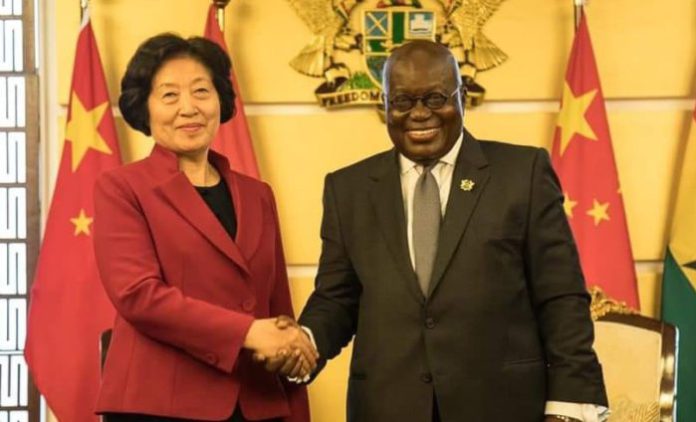
In its quest to fix the severe infrastructure deficit in the country, the government entered into a $2 billion Master Project Support Agreement (MPSA) with the Chinese state-run, Sinohydro Corporation Limited in September 2018.
Under the deal, Sinohydro, a hydropower engineering and construction firm, will finance and execute the construction of infrastructural projects across the length and breadth of Ghana in exchange to have access to sites to mine bauxite.
The Atiwa forest was subsequently earmarked as the site to be exploited by the Chinese company for 15 years.
Located in the country’s southeastern part, Atiwa forest is a 26,000 hectares area rich in bauxite and other mineral resource deposits like manganese and iron.
According to the US geological department, the Atiwa forest holds more than 960 million metric tonnes of bauxite reserves valued at more than $500 billion.
It is against this background of sealed wealth that government was able to secure what it touted as an unprecedented barter arrangement to fix Ghana’s infrastructural needs.
Seeking the permission of Parliament in July 2018, the Akufo-Addo administration argued that all the 16 regions will experience remarkable infrastructural growth from the Sinohydro arrangement.
The projects include hospitals, an extension of electricity to rural communities, construction of court and residential buildings for the Judicial Service, landfill sites and industrial parks.
Broken down into phases, the first phase of the project costs $646.6 million, and it begins with the Tamale Interchange project.
Parliament approved projects from lot one to 10 under the first phase.
Lot 1 – Construction of Accra Inner City Roads. A total of 84 kilometres of roads located in Trobu, Anyaa-Sowutoum, Dome-Kwabenya, Adenta and Teshie will be constructed;
Lot 2 – Construction of Kumasi and Mampong Inner City Roads. A total of 100 kilometres of inner-city roads will be constructed in Kumasi and Mampong. In Kumasi, the affected road networks are in Manhyia, Suame, Tafo Pankrono, Asokwa, Kwadaso, Oforikrom, Subin, Nhyiaeso and Bantama;
Lot 3 – Construction of the Tamale Interchange;
Lot 4 – Construction of the PTC Roundabout Interchange, in Sekondi-Takoradi, the first interchange in the western part of our country;
Lot 5 – Dualisation of the Adenta-Dodowa Road. 14 kilometres of the Adenta-Dodowa Road will be dualised so as to reduce congestion, improve road safety, and reduce travel times on the corridor;
Lot 6 – Construction of Sunyani Inner City and Berekum Township Roads. A total of 39 kilometres of roads will be constructed in Sunyani and Berekum Township. In Sunyani, 29 kilometres of inner-city roads will be constructed, whilst Berekum Township will see 10 kilometres of its roads constructed;
Lot 7 – Construction of Prestea Township and Cape Coast Inner City Roads. A total of 32 kilometres of roads will be constructed in Cape Coast and Prestea. In Cape Coast, 22 kilometres of inner-city roads will be constructed, whilst Prestea Township will see 10 kilometres of roads constructed;
Lot 8 – Upgrading of Selected Feeder Roads in Ashanti and Western Regions. Sixty-eight kilometres of feeder roads in the Ashanti and Western North regions will be rehabilitated. The roads that will be rehabilitated are mainly in communities that have bauxite deposits;
Lot 9 – Rehabilitation of Akim Oda-Ofoase Road. This lot involves the rehabilitation of the 38 kilometre Akim Oda-Ofoase road, which is part of the trunk road network, IR3, and passes through several rural communities that connect Akim Oda to Ofoase;
RELATED:
Lot 10 – Construction of the Hohoe-Jasikan-Dodo Pepesu Road of the Eastern Corridor. This will involve the construction of the 66-kilometre section of the Eastern Corridor Road between Hohoe to Jasikan and Dodo Pepesu.
The second phase of the project was expected to come on stream after approval by Parliament.
However, Sinohydro deal has faced criticism by civil society organisations on the grounds that it will be mined beneath the forest posing environmental concerns.
Also, the Minority in Parliament expressed concern that the $2 billion deal between Ghana and Sinohydro will only add up to the debt stock of the country, thereby, burdening the already burdened taxpayer.
Meanwhile, in a yet to be aired documentary titled “Where is the $2 billion Sinohydro deal?” JoyNews learned that government has only managed to access $100 million for the first phase of the project.
Evans Mensah, therefore, went all out to find the answer to the question, “So what happened to the Synohydro money and the projects it was to fund?”




![CRC engages Akufo-Addo, Bawumia and Kyei Mensah-Bonsu [Photos]](https://www.adomonline.com/wp-content/uploads/2025/06/Constitutional-Review-Committee-218x150.jpg)

